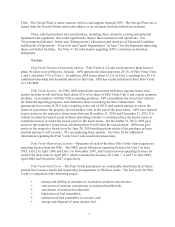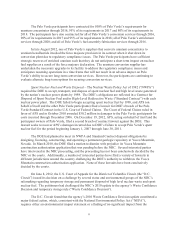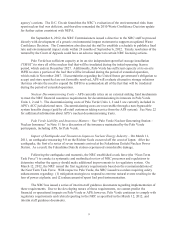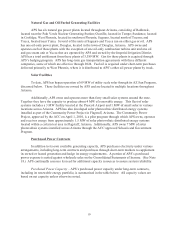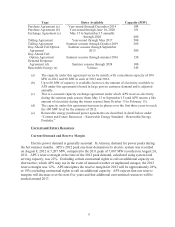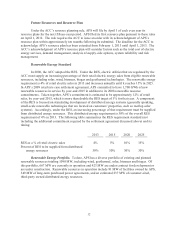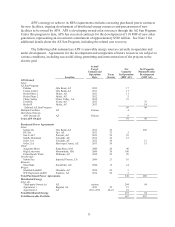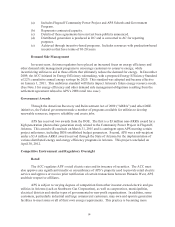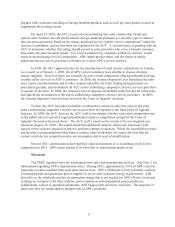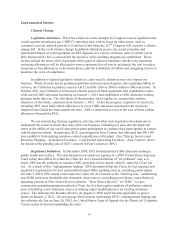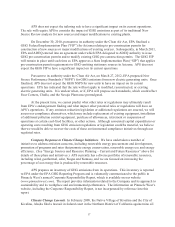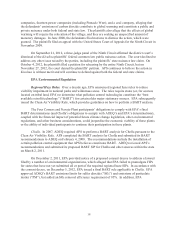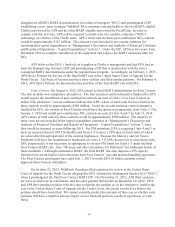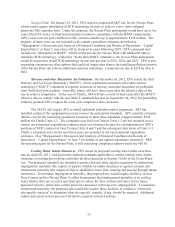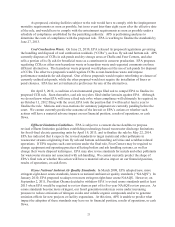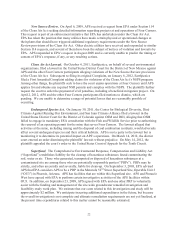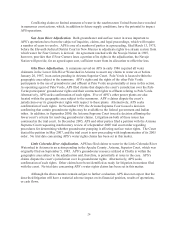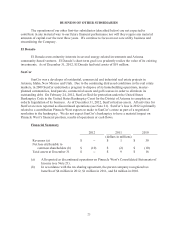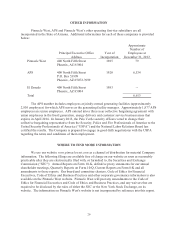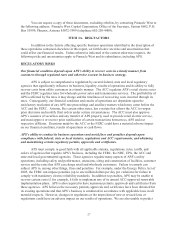APS 2012 Annual Report Download - page 41
Download and view the complete annual report
Please find page 41 of the 2012 APS annual report below. You can navigate through the pages in the report by either clicking on the pages listed below, or by using the keyword search tool below to find specific information within the annual report.17
APS does not expect the tailoring rule to have a significant impact on its current operations.
The rule will require APS to consider the impact of GHG emissions as part of its traditional New
Source Review analysis for new sources and major modifications to existing plants.
On December 30, 2010, pursuant to its authority under the Clean Air Act, EPA finalized a
GHG Federal Implementation Plan (“FIP”) for Arizona relating to pre-construction permits for
construction of new sources or major modifications of existing sources. Subsequently, in March 2011,
EPA and ADEQ entered into an agreement under which EPA delegated to ADEQ authority to issue
GHG pre-construction permits and to modify existing GHG pre-construction permits. The GHG FIP
will remain in place until such time as EPA approves a State Implementation Plan (“SIP”) that applies
pre-construction permit requirements to GHG-emitting stationary sources in Arizona. APS does not
expect the GHG FIP to have a significant impact on its current operations.
Pursuant to its authority under the Clean Air Act, on March 27, 2012, EPA proposed New
Source Performance Standards (“NSPS”) for GHG emissions from new electric generating units. Once
finalized, APS does not expect the GHG NSPS for new units to have an impact on its current
operations. EPA has indicated that the rule will not apply to modified, reconstructed, or existing
electric generating units. It is unclear when, or if, EPA will propose such standards, which could affect
Four Corners, Cholla, and the Navajo Plant once promulgated.
At the present time, we cannot predict what other rules or regulations may ultimately result
from EPA’s endangerment finding and what impact other potential rules or regulations will have on
APS’s operations. If any emission reduction legislation or additional regulations are enacted, we will
assess our compliance alternatives, which may include replacement of existing equipment, installation
of additional pollution control equipment, purchase of allowances, retirement or suspension of
operations at certain coal-fired facilities, or other actions. Although associated capital expenditures or
operating costs resulting from GHG emission regulations or legislation could be material, we believe
that we would be able to recover the costs of these environmental compliance initiatives through our
regulated rates.
Company Response to Climate Change Initiatives. We have undertaken a number of
initiatives to address emission concerns, including renewable energy procurement and development,
promotion of programs and rates that promote energy conservation, renewable energy use and energy
efficiency. (See “Energy Sources and Resource Planning – Current and Future Resources” above for
details of these plans and initiatives.) APS currently has a diverse portfolio of renewable resources,
including wind, geothermal, solar, biogas and biomass, and we are focused on increasing the
percentage of our energy that is produced by renewable resources.
APS prepares an inventory of GHG emissions from its operations. This inventory is reported
to EPA under the EPA GHG Reporting Program and is voluntarily communicated to the public in
Pinnacle West’s annual Corporate Responsibility Report, which is available on our website
(www.pinnaclewest.com). The report provides information related to the Company and its approach to
sustainability and its workplace and environmental performance. The information on Pinnacle West’s
website, including the Corporate Responsibility Report, is not incorporated by reference into this
report.
Climate Change Lawsuit. In February 2008, the Native Village of Kivalina and the City of
Kivalina, Alaska filed a lawsuit in federal court in the Northern District of California against nine oil


